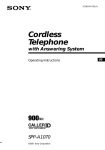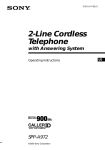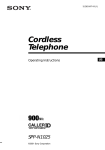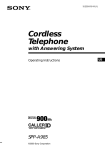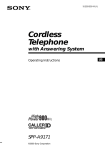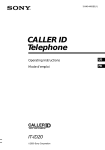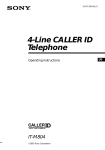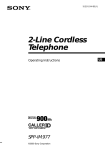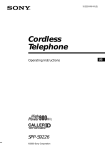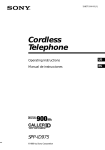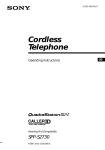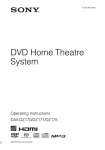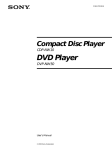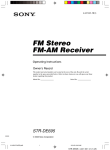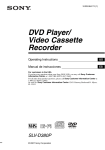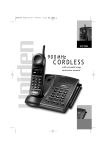Download Sony SPP IM982 Cordless Phone (SPP
Transcript
3-223-744-11 (1) 2-Line Cordless Telephone Operating Instructions SPP-IM982 ©2000 Sony Corporation US Owner’s Record The model and the serial numbers are located at the bottom of the unit. Record the serial number in the space provided below. Refer to these numbers whenever you call upon your Sony dealer regarding this product. Model No. SPP-IM982 Serial No. ________________ 2US IMPORTANT SAFETY INSTRUCTIONS When using your telephone equipment, basic safety precautions should always be followed to reduce the risk of fire, electric shock and injury to persons, including the following: 1. Read and understand all instructions. 2. Follow all warnings and instructions marked on the product. 3. Unplug this product from the wall outlet before cleaning. Do not use liquid cleaners or aerosol cleaners. Use a damp cloth for cleaning. 4. Do not use this product near water, for example, near a bath tub, wash bowl, kitchen sink, or laundry tub, in a wet basement, or near a swimming pool. 5. Do not place this product on an unstable cart, stand, or table. The product may fall, causing serious damage to the product. 6. Slots and openings in the cabinet and the back or bottom are provided for ventilation. To protect it from overheating, these openings must not be blocked or covered. The openings should never be blocked by placing the product on the bed, sofa, rug, or other similar surface. This product should never be placed near or over a radiator or heat register. This product should not be placed in a built-in installation unless proper ventilation is provided. 7. This product should be operated only from the type of power source indicated on the marking label. If you are not sure of the type of power supply to your home, consult your dealer or local power company. 8. Do not allow anything to rest on the power cord. Do not locate this product where the cord will be abused by persons walking on it. 9. Do not overload wall outlets and extension cords as this can result in the risk of fire or electric shock. 10. Never push objects of any kind into this product through cabinet slots as they may touch dangerous voltage points or short out parts that could result in a risk of fire or electric shock. Never spill liquid of any kind on the product. 11. To reduce the risk of electric shock, do not disassemble this product, but take it to a qualified service personnel when some service or repair work is required. Opening or removing covers may expose you to dangerous voltages or other risks. Incorrect reassembly can cause electric shock when the appliance is subsequently used. 12. Unplug this product from the wall outlet and refer servicing to qualified service personnel under the following conditions: A. When the power cord or plug is damaged or frayed. B. If liquid has been spilled into the product. C. If the product has been exposed to rain or water. D. If the product does not operate normally by following the operating instructions. Adjust only those controls that are covered by the operating instructions because improper adjustment of other controls may result in damage and will often require extensive work by a qualified technician to restore the product to normal operation. E. If the product has been dropped or the cabinet has been damaged. F. If the product exhibits a distinct change in performance. 3US 13. Avoid using a telephone (other than a cordless type) during an electrical storm. There may be a remote risk of electric shock from lightning. 14. Do not use the telephone to report a gas leak in the vicinity of the leak. SAVE THESE INSTRUCTIONS CAUTION: To reduce the risk of fire or injury to persons by battery, read and follow these instructions. 1. Use only the following type and size battery pack: Sony BP-T23. 2. Do not dispose of the battery pack in a fire. The cell may explode. Check with local codes for possible special disposal instructions. 3. Do not open or mutilate the battery pack. Released electrolyte is corrosive and may cause damage to the eyes or skin. It may be toxic if swallowed. 4. Exercise care in handling battery pack in order not to short the battery with conducting materials such as rings, bracelets, and keys. The battery or conductor may overheat and cause burns. 5. Charge the battery pack provided with or identified for use with this product only in accordance with the instructions and limitations specified in the instruction manual provided for this product. 6. Observe proper polarity orientation between the battery pack and battery charger. INFORMATION FOR GENERAL TELEPHONES 4US 3. This equipment is designed to be connected to the telephone network or premises wiring using a compatible modular jack that is Part 68 compliant. The FCC compliant telephone cord and modular plug is provided with this equipment. 4. The REN is used to determine the quantity of devices that may be connected to the telephone line. Excessive RENs on the telephone line may result in the devices not ringing in response to an incoming call. Typically, the sum of the RENs should not exceed five (5.0).To be certain of the number of devices that may be connected to a line, as determined by the total RENs, contact the local telephone company. 5. If this equipment (SPP-IM982) causes harm to the telephone network, the telephone company will notify you in advance that temporary discontinuance of service may be required. But if advance notice isn’t practical, the telephone company will notify the customer as soon as possible. Also, you will be advised of your right to file a complaint with the FCC if you believe it is necessary. 6. The telephone company may make changes in its facilities, equipment, operations or procedures that could affect the operation of the equipment. If this happens the telephone company will provide advance notice so you can make necessary modifications to maintain uninterrupted service. 7. If trouble is experienced with this equipment (SPP-IM982), for repair or warranty information, please contact Sony Direct Response Center: Tel 1-800-222-7669. If the equipment is causing harm to the telephone network, the telephone company may request that you disconnect the equipment until the problem is resolved. 8. All repairs will be performed in an authorized Sony service station. 9. This equipment cannot be used to party lines or coin lines. 10.This equipment is hearing aid compatible. If your telephone is equipped with automatic dialers 1. This equipment complies with Part 68 of the FCC rules. On the bottom of this equipment is a label that contains, among other information, the FCC certification number and ringer equivalence number (REN) for this equipment. If requested, this information must be provided to the telephone company. 1. Remain on the line and briefly explain to the dispatcher the reason for the call. 2. The applicable certification jack (connector) USOC-RJ11C/W, RJ14C/W are used for this equipment. 2. Perform such activities in the off-peak hours, such as early morning or late evenings. When programming emergency numbers and (or) making test calls to emergency numbers: Caution You are cautioned that any changes or modifications not expressly approved in this manual could void your authority to operate this equipment. Note This equipment has been tested and found to comply with the limits for a Class B digital device, pursuant to Part 15 of the FCC Rules. These limits are designed to provide reasonable protection against harmful interference in a residential installation. This equipment generates, uses and can radiate radio frequency energy and, if not installed and used in accordance with the instructions, may cause harmful interference to radio communications. However, there is no guarantee that interference will not occur in a particular installation. If this equipment does cause harmful interference to radio or television reception, which can be determined by turning the equipment off and on, the user is encouraged to try to correct the interference by one or more of the following measures: – Reorient or relocate the receiving antenna. – Increase the separation between the equipment and receiver. – Connect the equipment into an outlet on a circuit different from that to which the receiver is connected. – Consult the dealer or an experienced radio/ TV technician for help. 5US Table of contents Getting Started 8 Read this first 9 Step 1: Checking the package contents 10 Step 2: Setting up the base unit 14 Step 3: Preparing the battery pack 17 Step 4: Entering the area code 20 Identifying the parts Basics 24 Making calls 26 Redialing 27 Making another call while talking 28 Receiving calls 31 Receiving a call while talking Telephone Features 32 Phone Directory 32 Storing phone numbers and names 34 Changing a stored name and/or phone number 35 Erasing a memory location 35 Making calls from the Phone Directory 37 Setting the ringer type 38 Turning off the ringer of the handset 39 Switching the phones during a call 39 To switch from the base unit to the handset 6US Table of contents 39 To switch from the handset to the base unit 40 Talking between the phones (Intercom) 40 To talk from the handset to the base unit 40 To talk from the base unit to the handset 41 Receiving a call while using the intercom 42 Transferring a call 42 To transfer from the base unit to the handset 43 To transfer from the handset to the base unit 44 Having a conference call 44 Making another call while talking 45 Receiving a call while talking 46 Switching conference from the handset to the base unit 46 Switching conference from the base unit to the handset 46 To join on the base unit while the handset is talking on one line 46 To join on the handset while the base unit is talking on one line 46 To join three-way conference (four-way conference) Caller ID Features 47 Understanding the Caller ID service 47 When you receive a call 48 Looking at the Caller ID list 48 Viewing the Caller ID list 49 Erasing data from the Caller ID list 51 Using the Caller ID list 51 Calling back a number from the Caller ID list 52 Storing a number of the Caller ID list into the Phone Directory 53 To change the number of digits of the phone number 55 Using “Caller ID with call waiting” service 56 Using visual message waiting service Additional Information 58 Mounting the base unit on a wall 59 Carrying the handset by the belt clip 60 Notes on power sources 61 Maintenance 62 Troubleshooting 65 Specifications 66 Index Back cover LIMITED WARRANTY Table of contents 7US Getting Started Read this first Before you use your phone, you must first set it up. Here’s a quick way to set up your phone: Steps 1, 2, 3 and 4. Step 1 (page 9) First, unpack the phone and the supplied accessories. Step 2 (pages 10 to 13) Next, you need to do three things to set up the base unit, including finding the best location for the base unit. Base unit Step 3 (pages 14 to 15) Then, insert the battery pack into the handset and charge it for more than 12 hours. Step 4 (pages 17 to 19) Finally, enter the area code to use the Caller ID service. Handset 8US Getting Started That’s it! Step 1 Checking the package contents Make sure you have received the following items in the package. If anything is missing, contact your local Sony dealer. Getting Started AC power adaptor (AC-T128) Telephone line cords (3) Base unit Wall bracket for base unit Handset Rechargeable battery pack (BP-T23) Belt clip Getting Started 9US Step 2 Setting up the base unit Do the following steps: • Choose the best location • Connect the base unit • Choose the dialing mode Choose the best location Where you place the base unit affects the reception quality of the handset. Away from noise sources such as a window by a street with heavy traffic Away from television sets and other electronic equipment Away from heat sources, such as radiators, airducts, and sunlight Away from a microwave oven Away from excessive moisture, extremely low temperatures, dust, mechanical vibration, or shock Away from a personal computer Near a central location and on a level surface Away from another cordless telephone CAUTION: • Should you experience intermittent loss of audio during a conversation, try moving closer to the base or move base unit away from other noise sources. • The cordless telephone operates at a frequency that may cause interference to nearby TVs and VCRs; the base unit should not be placed near or on the top of a TV or VCR; and, if interference is experienced, moving the cordless telephone farther away from the TV or VCR will often reduce or eliminate the interference. 10US Getting Started Connect the base unit If you want to hang the base unit on the wall, see page 58. To connect the base unit to a single outlet having two lines Getting Started 3 Hook the cord. To an AC outlet To DC IN 9V 2 AC power adaptor DATA jack (supplied AC-T128) 1 Telephone line cord (supplied) To L1/L1+L2 To the telephone outlet 1 Connect the telephone line cord to the L1/L1+L2 jack and to a telephone outlet. 2 Connect the AC power adaptor to the DC IN 9V jack and to an AC outlet. 3 Raise the antenna. Make sure it points towards the ceiling. continued Getting Started 11US Step 2: Setting up the base unit (continued) To connect the base unit to two separate outlets 3 Hook the cord. To an AC outlet To DC IN 9V 2 AC power adaptor DATA jack (supplied AC-T128) To the telephone outlets To L1/L1+L2 Telephone line cord (supplied) Line 1 1 To L2 Telephone line cord (supplied) Line 2 1 Connect the telephone line cords to the L1/L1+L2 and L2 jacks and to the telephone outlets. 2 Connect the AC power adaptor to the DC IN 9V jack and to an AC outlet. 3 Raise the antenna. Make sure it points towards the ceiling. 12US Getting Started Notes • Use only the supplied AC-T128 AC power adaptor. Do not use any other AC power adaptor. • Connect the AC power adaptor to a continuous power supply. • Place the base unit close to the AC outlet so that you can unplug the AC power adaptor easily. Polarity of the plug – + Modular Connecting a computer or FAX You can connect a computer or FAX, etc. to the DATA jack. L1 L2 To L1/L1+L2 and/or L2 SPP-IM982 Notes • L2 jack is used for receiving or sending computer or FAX data in addition to making or receiving calls. If a call comes in on L2 jack with the “call waiting” service while a computer or FAX connected to the DATA jack is receiving or sending data, that data may be effected. If you have data communication frequently, we recommend that you and your callers use L2 jack for data communication only. • If you have only single outlet having one line, connect the telephone line cord to the L2 jack. Getting Started Tips • If your telephone outlet is not modular, contact your telephone service company for assistance. • L1 is the first phone line connected to center pair of wires. L2 is the second phone line connected to outer pair of wires. To DATA Computer or FAX Choose the dialing mode For the telephone to work properly, select an appropriate dialing mode (tone or pulse). Depending on your dialing system, set the DIAL MODE switch as follows: If your dialing system is Set the switch to Tone TONE Pulse PULSE If you aren't sure of your dialing system Make a trial call with the DIAL MODE switch set to TONE. If the call connects, leave the switch as is; otherwise, set to PULSE. DIAL MODE switch Getting Started 13US Step 3 Preparing the battery pack Charge the battery pack for more than 12 hours before you start using your phone. 1 Slide open the battery compartment lid of the handset. 2 Insert the battery pack (with BP-T23 contacts facing down) into the battery compartment. 3 Close the battery compartment lid. 4 Place the handset on the base unit. You can place it with either side facing up. The CHARGE lamp lights up when the handset is properly seated on the charge terminals of the base unit. Charge the battery pack for more than 12 hours so that the battery is fully charged. The CHARGE lamp remains lit even after charging is completed. CHARGE lamp 14US Getting Started Battery duration A fully charged battery pack lasts for about: • Approx. 7 hours when you use the handset continuously • Approx. 7 days when the handset is in standby mode. Getting Started Notes • The battery pack will gradually discharge over a long period of time, even when not in use. • If you leave the battery pack in the handset without charging it, the battery pack will be completely discharged. It may require several times of charging to recover to its full capacity. To obtain the best performance from the battery Do not place the handset on the base unit after each call. The battery works best if the handset is returned to the base unit after two or three calls. However, do not leave the handset off the base unit for a long period of time as this will completely discharge the battery pack. When to purchase a new battery pack If the battery lasts only a few minutes even after 12 hours of charging, the usable life of the battery has expired and needs replacement. Contact your local Sony authorized dealer or service center, and ask for a Sony BP-T23 rechargeable battery pack. Note Battery life may vary depending on usage condition and ambient temperature. continued Getting Started 15US Step 3: Preparing the battery pack (continued) Handset spare battery usage As only one battery pack is supplied with this unit, it is necessary to purchase an additional battery pack (optional) for use as a handset spare battery pack. 1 Openthebatterycompartment lid of the base unit. 2 Insert the battery pack (with BP-T23 contacts facing down) into the battery compartment. 3 Close the battery compartment lid. The SPARE BATT lamp lights up. Charge the battery pack for more than 24 hours so that the battery is fully charged. The SPARE BATT lamp remains lit even after charging is completed. SPARE BATT lamp 16US Getting Started Step 4 Entering the area code When you use this phone for the first time, or move to an area that has a different area code, you must enter your home area code. Otherwise, you cannot use some functions of this phone and the Caller ID functions. Depending on your region, enter 3-digit area code as follows: Case 1. If 7-digit dialing (no area code) is accepted for local calls in your area, see “To enter your home area code” below. If you live in an area where calls from or to other local areas can also be made by 10-digit dialing (area code + number), you can register up to 5 local area codes with this telephone to take advantage of this system. See “To enter the local area code (For 10 digits phone number users)” on page 18. Getting Started This is also necessary because the phone must be able to select an area code to properly dial call from the Caller ID list. Case 2. If 10-digit dialing (area code + number) is required for all local calls in your area, at first, enter “000” in your home area code. See “To enter your home area code” below. Then see “To enter the local area code (For 10 digits phone number users)” on page 18. To enter your home area code Turn Press 1 Press (PGM). 2 Turn Jog Dial up to make “AREA” flash. DIRECTORY AREA RINGER 3 Press Jog Dial. HOME LOCAL 4 Press Jog Dial again. “ENTER AREA CODE” appears on the display. continued Getting Started 17US Step 4: Entering the area code (continued) 5 Enter three digits of your home area code using the dialing keys. 6 Press (PGM). You will hear a long confirmation beep. Notes • If the home area code is already entered, it appears on the display in step 4. To enter a different home area code, see “To change the home area code” below. • Do not allow more than 20 seconds to elapse between each step of the procedure. Tips • You may press Jog Dial instead of (PGM) in step 6. • To check the current home area code, perform steps 1 to 4. The home area code appears on the display for about 20 seconds. To change the home area code 1 Perform steps 1 to 4 on page 17. The current home area code appears on the display. 2 Turn Jog Dial down to erase the current home area code. 3 Enter a new home area code using the dialing keys. 4 Press (PGM). You will hear a long confirmation beep. To enter the local area code (For 10 digits phone numbers users) If a call matches one of the local area codes you entered, the phone number will be registered with 10 digits in the Caller ID list (area code + number). If a call does not match one of the local area codes you entered, the phone number will be registered with 11 digits in the Caller ID list (1 + area code + number). Some regions of the country allow you to have more than one local area code. (Up to five local area codes can be entered in this phone.) 1 Perform steps 1 to 3 on page 17. 2 Turn Jog Dial up to make ”LOCAL“ flash. HOME LOCAL 3 Press Jog Dial. #1 #2 #3 #4 #5 18US Getting Started Select the number (”#1“ to ”#5“) to enter the local area code by turning Jog Dial. 5 Press Jog Dial. ”ENTER AREA CODE“ appears on the display. 6 Enter three digits of the local area code using the dialing keys. 7 Press (PGM). You will hear a long confirmation beep. Getting Started 4 Notes • If the local area code is already entered, it appears on the display in step 5. To enter a different local area code, see “To change the local area code” below. • Do not allow more than 20 seconds to elapse between each step of the procedure. Tips • You may press Jog Dial instead of (PGM) in step 7. • To check the current local area code, perform steps 1 to 5. The local area code appears on the display for about 20 seconds. To change the local area code 1 Perform steps 1 to 5 on pages 18 to 19. The current local area code appears on the display. 2 3 4 Turn Jog Dial down to erase the current local area code. Enter a new local area code using the dialing keys. Press (PGM). You will hear a long confirmation beep. To erase the local area code You can erase the local area code. Perform steps 1 and 2 above, then press (PGM). The local area code will be erased, and you will hear a long confirmation beep. Getting Started 19US Identifying the parts Refer to the pages indicated in parentheses for details. Base Unit 9 1 2 3 4 5 0 qa qs qd qf qg qh qj qk 6 7 8 1 NEW CALL lamp (p. 48) Flashes when there is a “NEW” data in the Caller ID list. 2 MESSAGES lamp (p. 56) Flashes when you have messages. 3 SPARE BATT lamp (p. 16) Lights while the spare battery is being charged. 4 CHARGE lamp (p. 14) Lights while the battery is being charged. 5 Battery compartment (p. 16) 6 MUTING button (p. 30) Mutes your voice during a conversation. 7 MIC (microphone) 8 LINE buttons (1, 2) (p. 29) Lets you receive a call. 9 Antenna (p. 11, 58) 20US Getting Started 0 Speaker qa VOL +/– buttons (p. 30) Adjusts the speaker volume. qs HOLD button (p. 30) Puts a call on hold. qd CONF (conference) button (p. 44) Lets you talk with two parties at the same time. qf DIAL MODE switch (p. 13) Selects pulse or tone dialing. qg INTERCOM button (p. 40) Lets you talk between the base unit and handset. qh RINGER LEVEL switches (L1, L2) (p. 30) Adjusts the ringer volume. qj CALL WAITING/FLASH button (p. 30) Switches to a second call if you have “call waiting” service, or lets you make a new call. Getting Started wd ql w; wa ws qk OFF button (p. 29) Allows you to disconnect the call. ql Hook for AC power adaptor cord (p. 11) w; DC IN 9V jack (p. 11, 58) wa L1/L1+L2 jack (p. 11, 58) ws L2 jack (p. 12, 58) wd DATA jack (p. 13) continued Getting Started 21US Identifying the parts (continued) Handset 1 2 0 3 4 5 6 7 8 9 qa qs qd qf qg qh qj 1 Antenna 2 Speaker 3 Jog Dial (p. 17, 32, 48) 4 LINE buttons (1, 2) (p. 24, 28) Lets you make or receive a call. 5 INTERCOM button (p. 40) Lets you talk between the base unit and handset. 6 HOLD button (p. 25) Puts a call on hold. 7 Battery compartment (p. 14) 8 TONE button (p. 25) Allows you to switch temporarily to tone dialing. 22US Getting Started 9 CONF (conference) button (p. 44) Lets you talk with two parties at the same time. q; Display window (p. 24, 47) qa OFF button (p. 24) Allows you to disconnect the call. qs FLASH/CALL WAITING button (p. 25, 55) Switches to a second call if you have “call waiting” service, or lets you make a new call. qd Dialing keys (p. 24) qf # button (p. 53) Used to change the number of digits of the phone number in the Caller ID list. Getting Started qk ql qg REDIAL/PAUSE button (p. 26, 33) Redials the last number called/ inserts a pause in the dialing sequence. qh PGM (program) button (p. 17, 32) Used to store numbers in Phone Directory. qj Microphone qk I (HEADSET) jack (p. 24, 28, 59) ql VOL (volume) switch (p. 25) Adjusts the handset volume. Getting Started 23US Basics Making calls 1 Pick up the handset from the base unit. 2 Press (LINE 1) or (LINE 2) to select the line. The corresponding line button lights up. I (HEADSET) jack VOL switch (HOLD) “TALK” appears on the display and the display also shows the talk time in hours, minutes and seconds. You will then hear a dial tone. The line button on the base unit double flashes in succession. (*TONE) (FLASH/CALL WAITING) (REDIAL/PAUSE) If “CHANNEL SEARCHING...” appears on the display, move closer to the base unit. 3 Dial the phone number. 4 When you’re done talking, press (OFF) or replace the handset on the base unit. The display and the LINE 1 or LINE 2 button go off. Making calls when the headset is connected When the TL-HD1 headset (optional) is connected to the I (HEADSET) jack, you can talk through the headset. Precaution Avoid listening your headset at so loud a volume that extended play might affect your hearing. 24US Basics Additional tasks To Do this Adjust the handset volume Set the VOL switch to H (high), M (middle) or L (low). Put a call on hold Press (HOLD). The LINE 1 or LINE 2 button will flash slowly. Press (LINE 1) or (LINE 2) to resume the conversation. Switch to tone dialing temporarily Press (*TONE) after you’re connected. The line will remain in tone dialing until disconnected. Switch to another call (“call waiting” service*) Press (FLASH/CALL WAITING). Press (FLASH/CALL WAITING) again to return to the first caller. Basics * You need to subscribe to the service from your telephone company. Notes • When you increase the sound volume, in some cases the back ground noise may be increased as well. You should adjust the volume accordingly. • If your conversation is muted and “CHANNEL SEARCHING...” appears on the display, move closer to the base unit; otherwise, the call will be disconnected after one minute. Tips • If you pick up another phone connected to the same phone line, the hold will be automatically released and you will be able to resume conversation on that phone. • The LINE 1 or LINE 2 button on the handset double flashes in succession, when the base unit is used. If you press (LINE 1) or (LINE 2) whichever button is flashing, you can talk to the base unit and to the line connected. If the battery becomes weak during a call The handset will beep every three seconds five times and E and “BATTERY LOW” appears on the display. Finish your call and charge the battery pack. For optimum performance, charge the battery for a full 12 hours. Note that during the first 10 - 15 minutes of charging, the phone will be inactive, i.e., unable to make or receive a call. After this initial 10 - 15 minutes, you may be able to use the phone, but the battery duration will be very short; thus it is recommended that you fully charge the battery before the next usage. continued Basics 25US Making calls (continued) If you have a spare battery You can replace the battery pack without disconnecting the call during a conversation. To replace the battery pack, perform the following procedure. 1 Press (HOLD) on the handset. The call is on hold and “HOLD” appears on the display. 2 3 Replace the battery pack. Press (LINE 1) or (LINE 2) to resume the conversation. Redialing 1 Press (LINE 1) or (LINE 2) to select the line. The corresponding line button lights up. 2 Press (REDIAL/PAUSE) to redial the last number dialed. Note If the number exceeds 32 digits or if it is erased, five short error beeps will alert you that the number cannot be redialed. To check the phone number before redialing While the handset is not in use, press (REDIAL/PAUSE). The last number dialed is displayed for five seconds. To dial the number, press (LINE 1) or (LINE 2) while the number is displayed. Note The number will not be displayed if the last number dialed exceeds 32 digits or if it is erased. To erase the last phone number dialed While the handset is not in use, press (REDIAL/PAUSE) twice within five seconds. The number will be erased from the memory, and you will hear a long confirmation beep. 26US Basics Making another call while talking Example: Making a call on line 2 while talking on line 1 1 Press (HOLD) while talking. The line 1 is put on hold and the LINE 1 button flashes slowly. 2 3 Press (LINE 2). Dial a phone number for the second party. Now you can talk to the second party on line 2. 4 Basics To put on hold line 2 and resume the conversation on line 1, press (HOLD), and then (LINE 1). or To disconnect line 2 and resume the conversation on line 1, press (LINE 1). Note If you do not press (HOLD) in step 1, line 1 will be disconnected. You can talk with two parties at the same time using both line 1 and line 2, see “Having a conference call” on page 44. Basics 27US Receiving calls 1 When you hear the phone ring, press (LINE 1) or (LINE 2) whichever button is flashing. The corresponding line button lights up. I (HEADSET) jack VOL switch (HOLD) “TALK” appears on the display and the display also shows the talk time in hours, minutes and seconds. The line button on the base unit double flashes in succession. 2 When you’re done talking, press (FLASH/CALL WAITING) (OFF) or replace the handset on the base unit. The display and the LINE 1 or LINE 2 button go off. Receiving calls when the headset is connected When the TL-HD1 headset (optional) is connected to the I (HEADSET) jack, you can talk through the headset. Precaution Avoid listening your headset at so loud a volume that extended play might affect your hearing. 28US Basics Additional tasks To Do this Adjust the handset volume Set the VOL switch to H (high), M (middle) or L (low). Put a call on hold Press (HOLD). The LINE 1 or LINE 2 button will flash slowly. Press (LINE 1) or (LINE 2) to resume the conversation. Switch to another call (“call waiting” service*) Press (FLASH/CALL WAITING). Press (FLASH/CALL WAITING) again to return to the first caller. Turn on/off the ringer of the handset See “Turning off the ringer of the handset” on page 38. Basics * You need to subscribe to the service from your telephone company. Note If another call comes in by “call waiting” service while conversing with an outside caller, you will hear two short beeps. Tip To inform you of an incoming call, the display shows “** RINGING **” when ringing. If you have subscribed to the Caller ID service; • the caller’s number and/or name appears on the display when you receive a call (see page 47) or when another call comes in by “call waiting” service. • the ringer sound changes to a higher tone if the call matches the number stored in the Phone Directory (memory match function; see page 47). Receiving calls through the speakerphone When you hear the phone ring, press (LINE 1) or (LINE 2) whichever button is flashing. The corresponding line button lights up. When you’re done talking, press (OFF). To obtain the best speakerphone performance, see page 30. (MUTING) MUTING lamp (HOLD) (VOL) (LINE 1) L1 and L2 RINGER LEVEL switches (LINE 2) (OFF) (CALL WAITING/FLASH) continued Basics 29US Receiving calls (continued) Additional tasks To Do this Adjust the speaker volume During speakerphone conversation, press (VOL)(+) or (--). Each press of (VOL)(+) or (--) switches the speaker volume by one of 8 levels. Adjust the ringer volume of You can adjust the ringer volume of line 1 and 2 the base unit respectively. Set the L1 or L2 RINGER LEVEL switch on the base unit to HIGH, LOW or OFF. Put a call on hold Press (HOLD). The LINE 1 or LINE 2 button will flash slowly. Press (LINE 1) or (LINE 2) to resume the conversation. Mute your voice Press (MUTING) to disable the microphone. The MUTING lamp lights up. Press (MUTING) again to cancel. Switch to another call (“call waiting” service*) Press (CALL WAITING/FLASH). Press (CALL WAITING/FLASH) again to return to the first caller. * You need to subscribe to the service from your telephone company. Note Even when you set the L1 or L2 RINGER LEVEL switch on the base unit to OFF, the handset will ring when the ringer of the handset is turned on (see page 38). Tips • To inform you of an incoming call, the line button lights on and off according to the ring signal even when you set the L1 or L2 RINGER LEVEL switch on the base unit to OFF. • If there is an incoming call while on the intercom, the base unit will ring at a low level even when the L1 or L2 RINGER LEVEL switch on the base unit is set to OFF. To obtain the best speakerphone performance • You may not be able to hear the other party’s voice in a noisy place. Therefore, use the speakerphone in a quiet room. • Do not bring your hand or other object too close to the microphone or you will hear a shrill noise (“feedback”). • When the speaker volume is loud, or the base unit has been placed close to a wall, you may find that the volume drops suddenly. This is due to a circuit in the telephone designed to protect against feedback. In such cases, lower the speaker volume slightly. 30US Basics Receiving a call while talking If another call comes in while talking on the other line, the corresponding line button will flash. Example: Receiving a call on line 2 while talking on line 1 1 Press (HOLD) while talking. The line 1 is put on hold and the LINE 1 button flashes slowly. 2 Press (LINE 2). 3 To put on hold line 2 and resume the conversation on line 1, press (HOLD), and then (LINE 1). or To disconnect line 2 and resume the conversation on line 1, press (LINE 1). Now you can talk to another caller on line 2. Basics Notes • If you do not press (HOLD) in step 1, line 1 will be disconnected. • If another call comes in while talking on the base unit, a beep will be heard through the base unit and the corresponding line button on the base unit will flash. • If another call comes in while talking on the handset, a ringer tone will be heard once through the handset and the corresponding line button on the handset will flash. At this time, the base unit will ring and the corresponding line button will flash normally. You can talk with two parties at the same time using both line 1 and line 2, see “Having a conference call” on page 44. Basics 31US Telephone Features Phone Directory You can dial a number by scrolling through the Phone Directory, in which up to 50 phone numbers can be stored. Storing phone numbers and names Example: to store “SONY” “123-4567”. Turn 1 Press (PGM). Press (Be sure not to press (LINE 1) and (LINE 2).) DIRECTORY AREA RINGER If “DIRECTORY” is not flashing, turn Jog Dial down to make it flash. 2 Press Jog Dial. “ENTER NAME” appears. (REDIAL/PAUSE) 3 Enter the name using the dialing keys. You can enter up to 16 characters. Character table 32US Key Character (1) 1 (2) AtBtCt2 (3) DtEtFt3 (4) GtHtIt4 (5) JtKtLt5 (6) MtNtOt6 (7) PtQtRtSt7 (8) TtUtVt8 (9) WtXtYtZt9 (0) 0 (*) * (#) &t’t,t–t.t# Telephone Features Press a dialing key until the desired character appears. (See the character table for details.) Enter successive characters in the same way. To enter two characters assigned to the same key, or to enter a “space”, turn Jog Dial up to move the cursor to the right. Example: to enter “SONY”, press (7) four times (S), press (6) three times (O), turn Jog Dial up to move the cursor, press (6) twice (N), and press (9) three times (Y). SONY 4 Press (PGM). “ENTER NUMBER” appears. 5 Enter the phone number. SONY 1234567 You can enter up to 32 digits, including a tone and a pause, each of which is counted as one digit. When the phone number of 17 digits or more has been entered, the phone number appears in two lines. 1234567890123456 12 6 Press (PGM). You will hear a long confirmation beep, and the name and the number are stored. The display goes off. Telephone Features Notes • If you intend to save a 51st phone number, you will hear five short error beeps and “MEMORY FULL” will be displayed. You cannot store the phone number. To store another phone number, erase one of the stored phone numbers (see page 35). • Do not allow more than 20 seconds to elapse between each step of the procedure. • The total number of phone numbers which can be stored into the Phone Directory varies according to the number of digits of each phone number. If all the phone numbers consist of up to 16 digits, you can store up to 50 phone numbers. However, as the Phone Directory uses two-phone number memory to store one phone number of 17 digits or more, the total number of phone numbers which can be stored in the Phone Directory decreases two by two every time you store a phone number of 17 digits or more. Tips • If you have entered a wrong name or number in step 3 or 5, turn Jog Dial down to erase it. Then enter the correct name or number. • You may press Jog Dial instead of (PGM) in steps 4 and 6. To store a number to be dialed via Private Branch Exchange (PBX) Before entering a phone number in step 5 above, do as follows: 1 2 Enter the outside line access digit (e.g., 9). Press (REDIAL/PAUSE). continued Telephone Features 33US Phone Directory (continued) Changing a stored name and/or phone number 1 Display the name and phone number you want to change by doing steps 1 and 2 in “Making calls from the Phone Directory” on page 35. SONY 1234567 2 Press Jog Dial. DIAL EDIT ERASE 1234567 3 Turn Jog Dial up to make “EDIT” flash and press Jog Dial. SONY 1234567 The cursor flashes at the last character of the name. 4 Turn Jog Dial down to erase the characters and enter the new name. If you want to change only the number, skip this step. 5 Press Jog Dial. The cursor flashes at the last digit of the phone number. 6 SMITH 1234567 Turn Jog Dial down to erase the number and enter the new number. If you don’t want to change the number, skip this step. 7 Press Jog Dial. You will hear a long confirmation beep and the name and/or the number is changed. Tip When the phone number of 17 digits or more has been entered, “–” is displayed next to 15th digit and then the all digits are displayed in two lines after about two seconds. 34US Telephone Features Erasing a memory location 1 Display the name and phone number you want to erase by doing steps 1 and 2 in “Making calls from the Phone Directory”. SONY 1234567 2 Press Jog Dial. DIAL EDIT ERASE 1234567 3 Turn Jog Dial up to make “ERASE” flash and press Jog Dial. ERASE NO YES 1234567 4 Turn Jog Dial up to make “YES” flash, then press Jog Dial. You hear a long confirmation beep and the memory location is erased. Making calls from the Phone Directory 1 Press Jog Dial. Turn Press 2 Display the name and phone number you want to call. (LINE 2) (LINE 1) To search in alphabetical order: Turn Jog Dial up or down. To search by entering the initial character: Press the dialing key of the desired character, then turn Jog Dial. Telephone Features “DIRECTORY” appears on the display. SONY 1234567 3 Press Jog Dial. DIAL EDIT ERASE 1234567 4 Press Jog Dial again. The phone number will be dialed. continued Telephone Features 35US Phone Directory (continued) Tips • You may press (LINE 1) or (LINE 2) to make a call instead of doing steps 3 and 4. • When you press Jog Dial in step 4, the vacant line is automatically connected. When neither line is in use, line 1 is connected. About the search order The names appear in the following order when you turn Jog Dial up or down. t t • Alphabetical order: ABC...XYZ y symbols y * y # y 0 - 9 • Initial character: To search for “SONY” for example, press (7) and then turn Jog Dial to search through the names starting with P, Q, R, S or 7. 36US Telephone Features Setting the ringer type You can select a ringer type of the handset from four type. Turn Press 1 Press (PGM). 2 Turn Jog Dial up to make “RINGER” flash. DIRECTORY AREA RINGER 3 Press Jog Dial. LINE1 LINE2 4 Turn Jog Dial to choose the line you 5 Press Jog Dial. The current ringer type appears. RINGER 1 SELECTED 6 Press one of the dialing keys ((1) to Telephone Features want to set the ringer type. (4)) to select a ringer type. You will hear the corresponding ringer tone. 7 Press (OFF). continued Telephone Features 37US Setting the ringer type (continued) Turning off the ringer of the handset 1 2 Perform steps 1 to 5 on page 37. Press (0). You will hear a confirmation beep. 3 RINGER OFF SELECTED Press (OFF). When “RINGER” is set to “RINGER OFF” The handset won’t ring. You can still make calls, and also receive calls if another telephone connected to the same line rings to inform you on incoming calls. To turn the ringer on again Follow the instructions described in “Setting the ringer type” on page 37. 38US Telephone Features Switching the phones during a call You can easily switch between the handset and speakerphone on the base unit without disconnecting the call. The call on line 1 will be switched to line 1 on another phone and that on line 2 is switched to line 2. To switch from the base unit to the handset Example: While talking on line 1: 1 Press (HOLD) on the base unit. The call is on hold and “HOLD” appears on the display of the handset and the LINE 1 button flashes slowly. 2 Press (LINE 1) on the handset. (LINE 1) The LINE 1 button on the handset lights up and the LINE 1 button on the base unit double flashes in succession. To switch from the handset to the base unit Example: While talking on line 1: 1 Press (HOLD) on the handset. The call is on hold and “HOLD” appears on the display of the handset and the LINE 1 button flashes slowly. Telephone Features You can continue talking to the caller through the handset. 2 Press (LINE 1) on the base unit. (LINE 1) The LINE 1 button on the base unit lights up and the LINE 1 button on the handset double flashes in succession. You can continue talking to the caller through the speakerphone. Tip While talking through the speakerphone on the base unit (or handset), if you press (LINE 1) or (LINE 2) which is flashing on the handset (or base unit), you can talk to the base unit (or handset) and to the line connected. Telephone Features 39US Talking between the phones (Intercom) You can converse using the base unit and the handset. You can start the intercom from either phone. To talk from the handset to the base unit Press (INTERCOM) on the handset. After the base unit rings twice, you will be connected automatically. (OFF) When a person at the base unit answers, you can talk with each other. “INTERCOM” appears on the display of the handset and the INTERCOM lamp on the base unit lights up. When you are done talking or if no one answers the phone Press (OFF) on the handset. To talk from the base unit to the handset Press (INTERCOM) on the base unit. The base unit and handset ring and “** PAGING **” appears on the display of the handset. When a person at the handset presses (INTERCOM), you can talk with each other. “INTERCOM” appears on the display of the handset and the INTERCOM lamp on the base unit lights up. (OFF) INTERCOM lamp When you are done talking or if no one answers the phone Press (OFF) on the base unit. 40US Telephone Features Note While conversing with an outside caller via the base unit or handset, you cannot make an intercom call. If you press (INTERCOM), you will hear a busy tone. Tips • You can receive an intercom call on the handset even when “RINGER” is set to “RINGER OFF”. • You can receive an intercom call on the base unit even when the L1 or L2 RINGER LEVEL switch on the base unit is set to OFF. The base unit will ring at a low level. Receiving a call while using the intercom When a call comes in, “** RINGING **” appears on the display of the handset and only the base unit rings at a low level. The LINE 1 or LINE 2 button flashes. Press (LINE 1) or (LINE 2) whichever is flashing, then you can answer the call. Telephone Features Telephone Features 41US Transferring a call You can transfer a call between the handset and base unit without disconnecting the call. To transfer from the base unit to the handset 1 Press (INTERCOM) to page the handset. The call is put on hold on the base unit and the handset rings. “** PAGING **” appears on the display of the handset. (OFF) INTERCOM lamp 2 Press (INTERCOM) on the handset. “INTERCOM” appears on the display of the handset and the INTERCOM lamp on the base unit lights up. You can talk between the base unit and the handset. 3 Press (LINE 1) or (LINE 2) (LINE 2) (LINE 1) which is flashing on the handset to talk to the caller with the handset. “TALK” appears on the display of the handset. If no one answers the phone Press (OFF) on the base unit. Tips • You can receive an intercom call on the handset even when “RINGER” is set to “RINGER OFF”. • If you have accidentally pressed (HOLD) in step 1, just press (INTERCOM) and you will get the same result as by pressing (INTERCOM) only. 42US Telephone Features To transfer from the handset to the base unit 1 Press (INTERCOM) to page the base unit. The call is put on hold on the handset. (OFF) After the base unit rings twice, you will be connected automatically. When a person at the base unit answers, you can talk with each other. “INTERCOM” appears on the display of the handset and the INTERCOM lamp on the base unit lights up. 2 Press (LINE 1) or (LINE 2) The corresponding line button of the base unit lights up. (LINE 1) (LINE 2) INTERCOM lamp If no one answers the phone Press (OFF) on the handset. Telephone Features which is flashing on the base unit to talk to the caller with the base unit. Tip You can receive an intercom call on the base unit even when the L1 or L2 RINGER LEVEL switch on the base unit is set to OFF. The base unit will ring at a low level. Telephone Features 43US Having a conference call You can talk on two lines at the same time and you can also talk on one line, the handset and the base unit at the same time. Making another call while talking You can talk with two parties at the same time using both line 1 and line 2. (Three-way conference) 1 Press (HOLD) while talking on one line. The line in use is put on hold. 2 Press (LINE 1) or (LINE 2), whichever is not used. (LINE 2) (LINE 1) (OFF) 3 Dial a phone number for the second party. 4 Press (CONF) (conference) after the second party is connected. “CONFERENCE” appears on the display. (FLASH/CALL WAITING) Now you can talk to both parties. (HOLD) (LINE 1) (LINE 2) 44US (CONF) (OFF) (CALL WAITING/FLASH) Telephone Features Receiving a call while talking If another call comes in while talking, the LINE 1 or LINE 2 button on which another call is coming will flash. 1 Press (HOLD). The line in use is put on hold. 2 3 Press (LINE 1) or (LINE 2), on which another call is coming. Press (CONF) (conference). Now you can talk to both parties. (Three-way conference) Note If you do not press (HOLD) in step 1, the first line will be disconnected. To disconnect the lines during a three-way conference To disconnect both lines at the same time, press (OFF). To disconnect line 1 and talk on line 2 only: Press (LINE 2). To disconnect line 2 and talk on line 1 only: Press (LINE 1). Telephone Features To put the lines on hold during a three-way conference Press (HOLD). Both lines are put on hold. To resume the conversations on both lines: Press (CONF). To resume the conversation only on one line: Press (LINE 1) or (LINE 2), for the line you want. (The other line is kept on hold.) Tip During a three-way conference, you cannot use “call waiting” service even if you press (FLASH/CALL WAITING) or (CALL WAITING/FLASH). continued Telephone Features 45US Having a conference call (continued) Switching conference from the handset to the base unit 1 Press (HOLD) on the handset to put both lines on hold. The LINE 1 and LINE 2 buttons on the handset and the base unit flash. 2 Press (CONF) on the base unit to resume the conversation. Switching conference from the base unit to the handset 1 Press (HOLD) on the base unit to put both lines on hold. The LINE 1 and LINE 2 buttons on the base unit and the handset flash. 2 Press (CONF) on the handset to resume the conversation. To join on the base unit while the handset is talking on one line Press the double flashing (LINE 1) or (LINE 2) on the base unit. Now you can talk to the handset and to the line connected. To join on the handset while the base unit is talking on one line Press the double flashing (LINE 1) or (LINE 2) on the handset. Now you can talk to the base unit and to the line connected. To join three-way conference (four-way conference) Press (LINE 1) or (LINE 2). 46US Telephone Features Caller ID Features Understanding the Caller ID service Caller ID allows the caller’s phone number to be shown on the display before the call is answered. In order to use this feature, you must first subscribe to the Caller ID service. The name of this service may vary depending on your telephone company. To use this feature, be sure to enter your home area code (see page 17). When you receive a call The phone number appears on the display with the date and time as shown in the following example. If your Caller ID service includes the caller name service, the caller’s name also appears on the display (up to 15 letters). Caller’s name Caller’s phone number The date and time received The line which received the Caller ID data SMITH JOHN 1-201-123-4567 When you answer the call, the Caller ID display changes to the “TALK” display. Notes • The caller’s phone number and/or name will not appear in the following cases: - “OUT OF AREA”: when the call is made through a telephone company which does not offer Caller ID service (including international calls). - “PRIVATE”: when the call is “blocked.” For privacy reasons, many states allow callers the option to prevent his or her telephone data from being displayed on the other party’s Caller ID display. • If the call is from an office which uses multiple lines, the displayed phone number may not match the number you use to call the extension. Caller ID Features Tips • Even if the ringer of the handset is set to “RINGER OFF”, you can receive Caller ID data. • If a call comes in on both line 1 and 2 simultaneously, the display will show the data on line 1 and 2 alternately. About the memory match function If you receive a call from a phone number which is stored in the Phone Directory (see page 32), the ringer sound will change to a higher tone from the second ring. Note The memory match function does not work with “OUT OF AREA” or “PRIVATE” calls; and it may not work with calls made from an office which uses multiple lines because the number does not always match the one you stored in this phone. Caller ID Features 47US Looking at the Caller ID list The phone stores the data of the last 20 calls received including “OUT OF AREA” and “PRIVATE” calls. It keeps track of all calls received; even if they were not answered. Viewing the Caller ID list You can look through the Caller ID list to check the phone number and/or name of the calls received. Turn 1 Turn Jog Dial. The display shows the number of “NEW” (calls which you have not viewed) and “OLD” (calls which you have viewed) calls. NEW O8 OLD 12 2 Turn Jog Dial down to display older data or up to display newer data. Note If a 21st call is received, the oldest data is automatically erased. Tip If there is a “NEW” data, the NEW CALL lamp of the base unit flashes. 48US Caller ID Features NEW CALL lamp About the “*” mark SMITH JOHN * 1-201-123-4567 “*” appears if there are more than two calls from the same phone number. The older data will be replaced by the new data, so the calls are counted as only one call. Erasing data from the Caller ID list Old data will be erased automatically when a 21st call comes in, but you can also manually erase unnecessary data one by one or erase the entire list. To erase the phone number one by one Display the phone number you want to erase from the Caller ID list (see page 48). SMITH JOHN 1-201-123-4567 2 Press Jog Dial. DIAL PGM ERASE 1-201-123-4567 3 Turn Jog Dial up to make “ERASE” flash and press Jog Dial. ERASE NO YES 1-201-123-4567 4 Turn Jog Dial up to make “YES” flash, then press Jog Dial. Caller ID Features 1 You will hear a long confirmation beep and the data is erased. continued Caller ID Features 49US Looking at the Caller ID list (continued) To erase the entire list at once 1 Display any Caller ID data. SMITH JOHN 1-201-123-4567 2 Press Jog Dial. DIAL PGM ERASE 1-201-123-4567 3 Turn Jog Dial up to make “ERASE” flash and press Jog Dial. ERASE NO YES ALL 1-201-123-4567 4 Turn Jog Dial up to make “ALL” flash, then press Jog Dial. ALL ERASE NO YES 1-201-123-4567 5 Turn Jog Dial up to make “YES” flash, then press Jog Dial. NEW OO OLD OO You will hear a long confirmation beep and the entire list is erased. Note “ALL” appears only when all the data has become “OLD” data. If there is any “NEW” data, you cannot erase the entire list. 50US Caller ID Features Using the Caller ID list By using the Caller ID list, you can call back a phone number from the Caller ID list easily, or store numbers from the Caller ID list into the Phone Directory. Calling back a number from the Caller ID list 1 Display the phone number you Turn Press want to call from the Caller ID list (see page 48). SMITH JOHN 1-201-123-4567 2 Confirm the number and press Jog Dial. DIAL PGM ERASE 1-201-123-4567 3 Press Jog Dial again. The phone automatically dials the displayed number. Caller ID Features Notes • If the number displayed in step 1 is not the one you should call back, you can change the number of digits of the phone number as described on page 53. • If the phone is connected to a Private Branch Exchange (PBX), you may not be able to call back from the Caller ID list because an outside line access digit is necessary. • When neither line is in use, line 1 is automatically connected in step 3. If you want to select the line manually, press (LINE 1) or (LINE 2) after step 1. You will then be connected to the line you have chosen. continued Caller ID Features 51US Using the Caller ID list (continued) Storing a number of the Caller ID list into the Phone Directory 1 Display the name and phone number you want to store from the Caller ID list (see page 48). SMITH JOHN 1-201-123-4567 2 Confirm the number and press Jog Dial. DIAL PGM ERASE 1-201-123-4567 3 Turn Jog Dial up to make “PGM” flash and press Jog Dial. SMITH JOHN 12011234567 The cursor flashes at the end of the name. Enter or change the name, if necessary (see page 34). 4 Press Jog Dial. The cursor flashes at the end of the phone number. SMITH JOHN 12011234567 Enter or change the phone number, if necessary (see page 34). 5 Press Jog Dial again. You will hear a long confirmation beep and the name and number are stored. Notes • Do not allow more than 20 seconds to elapse between each step of the procedure. • If the number displayed in step 1 is not the one you should store, you can change the number of digits of the phone number as described on page 53. • If the phone is connected to a Private Branch Exchange (PBX), you may need to add an outside line access digit. 52US Caller ID Features To change the number of digits of the phone number If the number of digits of the phone number in the Caller ID list is different from the actual phone number, you need to adjust the number of digits of the phone number to call back or store into the Phone Directory . 1 While the phone number from the Caller ID list is displayed, press (#) repeatedly until the phone number with the correct number of digits appears on the display. Each time you press (#), the number of digits changes as follows: When the home area code and the local area code do not match SMITH JOHN 1-201-123-4567 SMITH JOHN 201-123-4567 SMITH JOHN 123-4567 SMITH JOHN 1-123-4567 When the home area code matches SMITH JOHN 1-201-123-4567 SMITH JOHN 1-123-4567 SMITH JOHN 201-123-4567 Caller ID Features SMITH JOHN 123-4567 continued Caller ID Features 53US Using the Caller ID list (continued) When the local area code matches 2 SMITH JOHN 201-123-4567 SMITH JOHN 1-123-4567 SMITH JOHN 1-201-123-4567 SMITH JOHN 123-4567 Continue the operation to call or store the phone number with the correct number of digits (pages 51 and 52). Notes • You need to adjust the number of digits each time you call back from the Caller ID list as the changes to the Caller ID data is not stored in memory. • You may not be able to change the number of digits depending on the Caller ID data. 54US Caller ID Features Using “Caller ID with call waiting” service This telephone is compatible with the “Caller ID with call waiting” service. Make sure that your telephone company offers this service. Like the basic Caller ID service, you need to subscribe to “Caller ID with call waiting” in order to use this service. Even though you may have already subscribed to “Caller ID” and “call waiting” as two separate services, you need to request a subscription to “Caller ID with call waiting” as a single service. This is a new service that combines the two services. Even though you now have a “Caller ID with call waiting” compatible phone, unless you subscribe to the combined “Caller ID with call waiting” service, you will not be able to see the name and number of the second caller. When a new call comes in while you are talking, you hear two short beeps. The caller’s name and/or phone number of the new call appears on the display for about 20 seconds. To switch to another caller 1 To switch to the new caller, press (FLASH/CALL WAITING). (If you’re at the base unit, press (CALL WAITING/FLASH).) press (FLASH/CALL WAITING) (or (CALL WAITING/FLASH)) again. Caller ID Features Caller ID Features 2 To switch back to the first caller, 55US Using visual message waiting service If you subscribe to your telephone company’s message service which includes this feature, the display will show that you have messages waiting to be retrieved. MESSAGES lamp If you have messages The MESSAGES lamp on the base unit flashes. The MESSAGES lamp will go off when you retrieve your messages. Note You cannot use this feature, if you have not subscribed to your telephone company’s message service. For details on the availability of this service, please ask your telephone company. If the MESSAGES lamp remains flashing If this lamp does not go off (e.g. When you retrieve your messages with other phones), you can go off the lamp manually. To go off the MESSAGES lamp 1 2 Press (PGM) on the handset. 3 Press Jog Dial. Press (#) on the handset. The MESSAGES lamp on the base unit goes off, and you will hear a long confirmation beep. 56US Caller ID Features MESSAGES WAITING LIGHT-OFF RESET Using visual message waiting service (continued) If you move or change your telephone company Message waiting signals are sent in one of two ways: FSK signaling or “stutter” signaling (Your telephone company can provide you with more information about your service). The first time this phone receives a voice mail message, it will set itself to the FSK service and will lock out the stutter service if your telephone company is in FSK service. When you move or change your telephone company, you need to perform the following procedure. The phone will returns to ready state for either FSK or stutter dial tone voice mail recognition. To reset this phone 1 2 3 Press (PGM) on the handset. Press (#) on the handset. Turn Jog Dial up to make “RESET” flash and press Jog Dial. MESSAGES WAITING LIGHT-OFF RESET You will hear a long confirmation beep and the phone is reset. Caller ID Features Caller ID Features 57US Additional Information Mounting the base unit on a wall 1 1 Raise the hang-up tab. 2 Plug the telephone line cord(s) Hang-up tab to the L1/L1+L2, and/or L2, DATA jack(s) and the AC power adaptor to the DC IN 9V jack, and hook the cords. 3 Attach the wall bracket to the center of the base unit. Align the f marks of the wall bracket with those of the base unit. 2 4 Plug the telephone line cord(s) AC power adaptor cord to the telephone outlet(s), and hook the base unit to the wall plate. Telephone line cord 5 Plug the AC power adaptor to an AC outlet. Then raise the antenna so that it points towards the ceiling. 3 4,5 Telephone line cord Wall plate Wall bracket AC outlet AC power adaptor Tip To remove the wall bracket, press the lower tabs. 58US Additional Information Carrying the handset by the belt clip You can hang the handset on the belt by attaching the belt clip to the handset. Attaching the belt clip Press the belt clip to the handset. Make sure that the side tabs click and go into the holes on the sides of the handset. Note To prevent the handset from dropping, make sure that each tab is completely inserted. Detaching the belt clip Note Remove the belt clip carefully to avoid breaking your fingernails. Using the headset You can talk on handset without using your hands by connecting Sony TL-HD1 headset (optional) to the I (HEADSET) jack on the handset. Additional Information Additional Information While pressing the back of the belt clip, pull the sides one by one until the tabs come off from the holes. 59US Notes on power sources On battery pack For the customers in the USA • Store the battery pack at a temperature between 41°F (5°C) and 95°F (35°C) for best performance. RECYCLING NICKEL-CADMIUM BATTERIES • If you do not use the handset for a long period of time, remove the battery pack from the handset after charging for more than 12 hours, and base unit after charging for more than 24 hours when you have a spare battery. This maintains battery life. On power failure During a power interruption, you cannot make or receive calls. Nickel-Cadmium batteries are recyclable. You can help preserve our environment by returning your unwanted batteries to your nearest point for collection, recycling or proper disposal. Note: In some areas the disposal of nickelcadmium batteries in household or business trash may be prohibited. RBRC (Rechargeable Battery Recycling Corporation) advises you about spent battery collection by the following phone number. Call toll free number: 1-800-822-8837 (United States and Canada only) Caution: Do not handle damaged or leaking nickel-cadmium batteries. 60US Additional Information Maintenance • Clean the cabinets with a soft cloth slightly moistened with water or a mild detergent solution. Do not use any type of abrasive pad, scouring powder or solvent such as alcohol or benzine as they may damage the finish of the cabinet. • If the charge terminals of the base unit and handset are soiled, wipe them with a soft cloth. If you have any questions or problems concerning your phone, please consult your nearest Sony dealer. Additional Information Additional Information 61US Troubleshooting Making calls If you’ve experienced any of the following difficulties while using your phone, use this troubleshooting guide to help you remedy the problem. Should any problem persist, consult your nearest Sony dealer. Symptom Remedy You hear five short error beeps when you press (LINE 1) or (LINE 2). • Make sure you have set up the base unit correctly (page 10). • Move the handset closer to the base unit. You hear no dial tone. • Make sure the telephone line cord is securely connected to the telephone outlet. • Make sure the battery is fully charged (page 14). The phone does not connect at all, even though the number you dial is correct. • Make sure the dialing mode is set correctly (page 13). The phone does not redial correctly. • Make sure the last dialed number is really the one you want to dial. You hear five short error beeps when you try to redial. • The number you last dialed exceeds 32 digits (including the tone and pause digits if used). • The number you last dialed is erased. Receiving calls You cannot perform the redial • Move the handset closer to the base unit and perform the redial operations again. operations (redialing, checking and erasing the phone number), and “CHANNEL SEARCHING...” appears on the display. 62US The handset does not ring. • Make sure the ringer is turned on (page 38). • The battery may be weak. Charge the battery for more than 12 hours (page 14). • Make sure you have set up the base unit correctly (page 10). • Move the handset closer to the base unit. The base unit does not ring. • Set the L1 or L2 RINGER LEVEL switch on the base unit to HIGH or LOW. • Make sure the telephone line cord is securely connected to the telephone outlet. Additional Information Remedy You hear interference during conversation. • Move the handset closer to the base unit. • Place the base unit away from noise sources (page 10). • This is the out-of-range alarm. Move the handset Your conversation is muted closer to the base unit within one minute. and “CHANNEL SEARCHING...” appears on the display. LINE 1 or 2 button flashes when not in use. • Either the handset or the base unit is being used. You hear five short error beeps and cannot store a number in the Phone Directory. • Make sure you follow the procedure for storing the number correctly (pages 32). • Make sure the number (including the tone and pause digits) does not exceed 32 digits. Phone Directory dialing is incorrect. • Store the correct number (pages 32). • The battery may be weak. Charge the battery for more The handset does not ring than 12 hours (page 14). when you use the intercom from the base unit, and the base • Move the handset closer to the base unit. • Place the base unit away from noise sources unit does not ring when you (page 10). use the intercom from the handset. When pressing (INTERCOM), you hear a busy tone and cannot make an intercom call. • Either the base unit or handset is being used to converse with an outside caller. Additional Information Intercom LINE 1 and 2 buttons • The battery is weak. Charge the battery for more than You hear a beep every three 12 hours (page 14). seconds and E and “BATTERY LOW” appear on the display. Phone Directory During conversation Symptom continued Additional Information 63US Power source/battery Caller ID Troubleshooting (continued) 64US Symptom Remedy The caller’s name and/or phone number does not appear on the display. • Make sure you have subscribed to Caller ID service. • Caller ID service may not work when the phone is connected to a Private Branch Exchange (PBX). • The call is made through company which does not offer Caller ID service. “OUT OF AREA” will appear on the display. • The call was “blocked”. “PRIVATE” will appear on the display. • You have answered the call while “** RINGING **” was displayed. Be sure to answer after the Caller ID data is displayed. The caller’s name and/or phone number does not appear on the display during call waiting. • Make sure you have subscribed to “Caller ID with call waiting” service (page 55). • Make sure nobody is talking with another phone on the same telephone line. You cannot dial the number from the Caller ID list. • Make sure you entered your home area code correctly (page 17). • You may need to change the number of digits of the phone number (page 53). • This function may not work when the phone is connected to a Private Branch Exchange (PBX). The memory match function does not work. • If the call is from an office which uses multiple lines, the phone number may not match the number you put in the memory. • If you have stored the phone number with an outside line access digit in the Phone Directory because the phone is connected to a Private Branch Exchange (PBX), the phone number will not match the Caller ID data. You cannot use visual massage waiting service. • Make sure you have subscribed to visual message waiting service (page 56). • If you move or change your telephone company, reset this phone (page 57). The CHARGE lamp does not light up when you place the handset to charge. • Wipe the charge terminals of the base unit and the handset with a soft cloth for better contact of the charge terminals. • Make sure the handset is placed on the base unit properly. The battery duration is short. • The battery pack was charged less than 12 hours (due to power failure, etc.). • The usage life of the battery has expired and needs replacement. The CHARGE lamp flashes. • Move the handset closer to the base unit. • Make sure the battery is inserted in the handset. • The battery may be completely discharged. Charge the battery for more than 12 hours (page 14). It may require several times of charging to recover to its full capacity. Additional Information Specifications General Base unit Frequency band 902 - 928 MHz Operating channel 30 channels Dial signal Tone, 10 PPS (pulse) selectable Supplied accessories See page 9. Power source DC 9V from AC power adaptor AC-T128 Battery charging time Approx. 24 hours Dimensions Approx. 6 3⁄ 4 x 2 3⁄4 x 8 3⁄4 inches (w/h/d), antenna excluded (approx. 171 x 68 x 221 mm) Antenna: Approx. 6 inches (approx. 150 mm) Mass Approx. 1 lb 5 oz (approx. 582 g), wall bracket excluded Handset Design and specifications are subject to change without notice. Additional Information Power source Rechargeable battery pack BP-T23 Battery charging time Approx. 12 hours Battery life Standby: Approx. 7 days Talk: Approx. 7 hours Dimensions Approx. 2 1⁄4 x 7 1⁄2 x 1 15⁄16 inches (w/h/d), antenna excluded (approx. 57 x 190 x 48 mm) Antenna: Approx. 3 1⁄2 inches (approx. 87 mm) Mass Approx. 9.5 oz (approx. 268 g), battery included Additional Information 65US Index A H S Adjusting volume handset volume 25, 29 speaker volume 30 Area code 17 Headset 24, 28, 59 Hold 25, 29 Home area code 17 B Identifying the parts 20 Intercom 40 Setting up base unit 10 handset 14 Spare battery 16 Speakerphone 29, 30 Storing Caller ID data in Phone Directory 52 Switching phones during a call 39 Battery pack charging 14 duration 15 C Call waiting service 25, 55 Caller ID 47 Caller ID list 48 calling back 51 memory match function 47 storing in Phone Directory 52 Caller ID with call waiting 55 Carrying the handset by the belt clip 59 Conference 44 Connection 11 D Dialing mode choosing 13 switching to the tone temporarily 25 Directory Phone Directory 32 E, F, G Erasing Caller ID data 49 last phone number dialed 26 local area code 19 Phone Directory 35 66US Additional Information I, J, K L Local area code 18 Location, base unit 10 T, U Making calls 24 Memory match function 47 Mounting the base unit on a wall 58 Muting 30 Talking between the phones 40 Three-way conference 44 Tone dialing dialing mode 13 switching to 25 Transferring a call 42 Troubleshooting 62 O V, W, X, Y, Z OUT OF AREA 47 Visual message waiting service 56 Volume handset 25, 29 speaker 30 M, N P, Q Package contents 9 Phone Directory 32 PRIVATE 47 Pulse dialing 13 R Receiving calls 28 Redialing 26 Ringer L1/L2 RINGER LEVEL switch 30 setting the ringer type 37 turning on/off 38 Additional Information Additional Information 67US 68US Additional Information Additional Information Additional Information 69US 70US Additional Information Additional Information Additional Information 71US For the customers in the USA Be sure to save the receipt and attach it to your WARRANTY card when having your equipment repaired at an authorized Sony service station. Sony Corporation Printed in China








































































